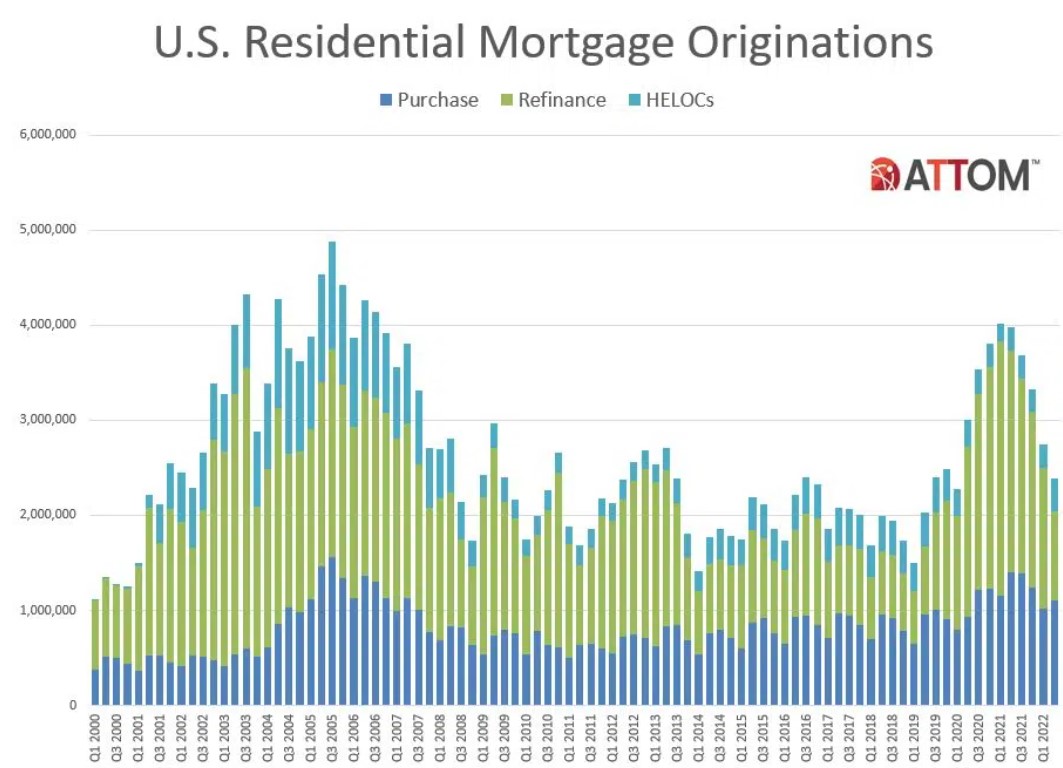 A new report from ATTOM Data paints a bleak picture of the current state of the refinance market amid rising interest rates which are expected to be raised by the Federal Reserve at least two more times.
A new report from ATTOM Data paints a bleak picture of the current state of the refinance market amid rising interest rates which are expected to be raised by the Federal Reserve at least two more times.
As of the end of the second quarter, the U.S. Residential Property Mortgage Origination Report revealed that refinance lending activity dropped 36% quarterly. In total, there were 2.39 million mortgages originated in the second quarter of 2022, a figure which is down 13% from the first quarter and is the fifth quarterly decrease in a row. On a yearly basis, this number is down 40% and is the biggest annual drop since 2014.
Most of the decline recorded resulted from another double-digit downturn in refinance activity that outweighed increases in home purchase and home equity loans.
The quarter also saw lenders issue $807.8 billion worth of mortgages, a number which is down 11% from last quarter and 35% year-over-year.
"Mortgage rates that have virtually doubled over the past year have decimated the refinance market and are starting to take a toll on purchase lending as well," said Rick Sharga, EVP of Market Intelligence at ATTOM. "The combination of much higher mortgage rates and rising home prices has made the notion of homebuying simply unaffordable for many prospective buyers, which threatens to drive loan volume down even further as we exit the spring and summer months."

Looking deeper, the downturn in total activity resulted in just 941,000 residential loans getting rolled over to new mortgages during the second quarter. This number, down 36% from last quarter and 60% year-over-year. The dollar volume of refinance loans stood at 310.1 billion, a number which is down 35% quarterly and 56% yearly.
For the first time since early 2019, refinance activity in the second quarter did not represent the largest chunk of mortgages, dropping to 39% of all loans. That was off from 53% in the first quarter and from a recent peak of 66% in early 2021.
Purchase loan activity, however, increased by 8% quarterly to 1.1 million, representing 46% of all origination activity. The dollar volume of loans taken out to buy residential properties rose to $431.4 billion, up 15% from the first quarter of this year, but still down 12% from the second quarter of last year.
The best-performing category of loans by far in the second quarter was again home-equity lending. Home Equity Lines of Credit shot up 35 percent quarterly and 44 percent annually, to 341,704.
"Borrowers looking to tap into their equity should know that HELOC activity has been particularly strong among credit unions and community banks, along with a small but growing number of depository banks," Sharga noted. "While non-bank mortgage lenders may begin to more aggressively originate home equity loans, it's not likely they'll be active participants in the HELOC market."
Click here to view the source report.

 theMReport.com Your trusted source for mortgage banking news
theMReport.com Your trusted source for mortgage banking news








